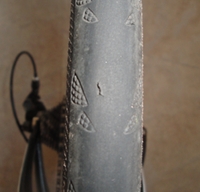It was a cold and rainy New Year’s Day ride when I first fell out of love with my Continental Gatorskin tires. No – strike that. That was when my ambivalent “Yea, they’re OK” turned into a “Why did I pay extra for Kevlar casing tires??”
 In hindsight, however, neither my ambivalence nor my negative impressions of the tires were correct. In fact, it was only because the tires performed so well that I was able to ride for so long without thinking about them in the first place.
In hindsight, however, neither my ambivalence nor my negative impressions of the tires were correct. In fact, it was only because the tires performed so well that I was able to ride for so long without thinking about them in the first place.
 The Gatorskin model, similar to the Specialized Armidillo, is a tire specifically designed for puncture resistance. While still a relatively light weight tire compared to other less expensive tires, at 280g you are definitely trading a bit of weight for durability.
The Gatorskin model, similar to the Specialized Armidillo, is a tire specifically designed for puncture resistance. While still a relatively light weight tire compared to other less expensive tires, at 280g you are definitely trading a bit of weight for durability.
That is probably why I initially – and incorrectly – got so frustrated when I was stuck in the rain changing a flat. I felt I had paid a premium both in dollars and in weight to protect myself from watching the group ride away while I sat messing around with my punctured tube. I dug a rather large piece of green glass out of the rubber that had pushed through the inner casing and hit the tube on that day. This was the exact scenario these tires were supposed to protect me from.
What I didn’t realize at the time, however, is that I probably didn’t pick up that piece of glass on the ride where I got the puncture. Rather, that piece of glass had likely been hidden in the rubber of my tire for some time, and the continued pressure against the inner casing finally resulted in a puncture.
I know what some of you are thinking: “You should be inspecting your tires regularly!” In fact, I do. But somewhat casually. I generally run my hand over the tire, looking for protruding thorns or road debris and pull them out.

It was after my New Year’s Day flat, however, that I got a little more aggressive in my inspection. I pulled the tire off of the rim and started carefully inspecting the tire. There were numerous slits in the tire – 10-12 of them. With the tire off of the rim I was able to flex the tire and open up these slits. What I found inside – invisible when the tire was mounted on the bike – amazed me.
After stealing the dental pick and tweezers from our bathroom, I was able to pull no less than 6 pieces of glass and 4 shards of wire that were completely embedded in the rubber, but had not penetrated the casing! Every one of these would have probably been a flat on “regular” tires, but all had been thwarted but the Gatorskin’s design.
I’m completely sold on these tires now. In my opinion they are well worth the slight premium you pay over comparable tires.
I carefully cleaned out every slit and nick I could find, applying a small blob of Super Glue to each to close it up. Those slits make it much easier for debris to stick to your tire, and sealing them closed helps to eliminate that risk. That 15-20 minutes I spent going over my tire not only taught me the benefits of a good sheet of kevlar, but also the value in spending some quality time with a dental pick and your tires.
While I had initially purchased the Gatorskin for the winter months, I can see myself riding these for training or non-competitive rides year round. They provide a comfortable ride, feel grippy on fast descents, and keep your spare tube carefully stored in your under-seat tool bag where it belongs.
Pingback: Today’s post, in which I get a new intern who doesn’t seem to grasp the concept « BikingInLA()